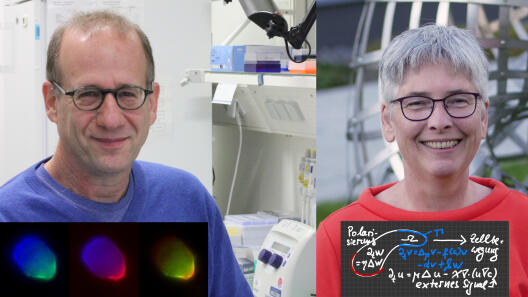New Topical Program on Cell Dynamics and Mathematical Modelling

The motion of cells, cell division, cell differentiation, and communication between cells rely strongly on biochemical signalling and biomechanics. Biomechanics and biochemical signalling are fundamental to the development of all embryos. Measurements and experiments in this context are naturally based on fundamental principles of physics, which means that mathematical gedankenexperiments are natural as well. Prof. Dr. Erez Raz, a cell biologist, and Prof. Dr. Angela Stevens, a mathematician, aim to further strengthen and deepen the exchange between experimental biology and mathematics in their new project "Cell Dynamics and Mathematical Modelling". It is one of eleven "Topical Programs" that have recently been funded by the University of Münster.
Erez Raz and Angela Stevens consider a deeper connection between biology and mathematics to be very fruitful. Mathematics here does not only mean calculations, data analysis, statistics, using mathematical formulas or simulating mathematical models, but, rather more abstractly and deeper, to provide "proofs of principle" for biology and medicine. Examples are questions of the following kind: Can a phenomenon which is observed in experiments be caused by certain hypothesised mechanisms – or not at all? What are the principle possible mechanisms for a biological phenomenon observed? Or – as in the case of the successful interplay between physics and mathematics – "the following" phenomenon should exist or should be observable, even though experiments cannot yet be done.
One of the main aims of this project is to develop hypotheses for the functioning of biological systems via mathematical gedankenexperiments. This concept has not yet been strongly implemented for the life-sciences but could be extremely useful, keeping in mind the very close collaboration between physics and mathematics. Inspired by physics, new mathematics was historically often developed, and answers to fundamental scientific questions were given. "In life-sciences, too, this concept has an enormous potential which has hardly been explored", says Angela Stevens. Analysing and classifying complex non-linear mathematical systems allow to understand whole sets of different mathematical models. In order to transfer such insights to the life-sciences, an intensive scientific exchange between biologists and mathematicians is necessary in order to identify the right submodels. Münster has established a strong "new" tradition for such an exchange between the life- and the mathematical sciences.
The central biological model organism in this new project is the zebrafish. Biomechanical properties and dynamical changes of the shape of its cells, as in other organisms, are closely connected to their specific cellular functions. This is also observed during the motion of primordial germ cells in zebrafish. These processes can be described mathematically and thus be analysed theoretically. Furthermore, the research on zebrafish is also relevant for the dynamics of wound healing and tumour growth, since immune cells and cancer cells share many morphogenetic properties with embryonic cells.
The funding provided by the Rectorate will be used primarily to organise a workshop in Münster, bringing together international scientists from biology, mathematics, medicine, physics, chemistry and computer science.
Topical Programs:
The so-called Topical Programs open up new topical fields for future research focuses at Münster University. Apart from this, the University aims to support international cooperation and to strengthen networking with external scientists and other university and non-university research institutes. Supported by external experts and an online review method, the University's Research Council has chosen eleven projects. An overview can be found in the University's newspaper "wissen leben" 12/2020 [de].

